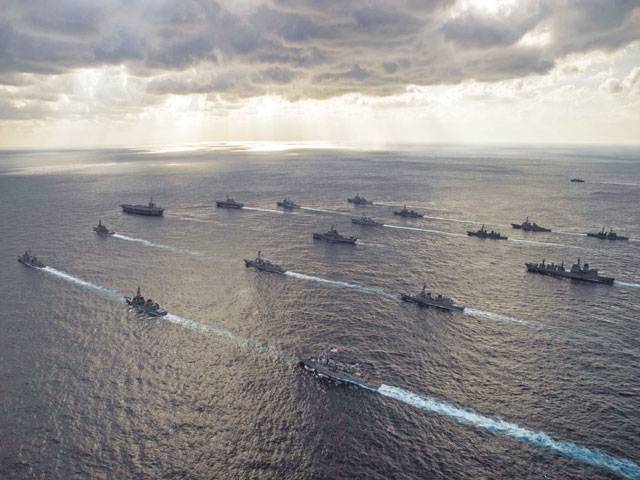ABOARD THE USS GEORGE WASHINGTON, PACIFIC OCEAN - Japan stepped up its role in large-scale war games with the United States this week, with one of its admirals commanding air and sea manoeuvres that the US military described as the most complex ever overseen by the Japanese navy.
The Keen Sword exercises involving more than 30,000 Japanese troops and 11,000 US personnel come as Prime Minister Shinzo Abe seeks a higher profile for Japan in the security alliance.
At the same time, Washington has encouraged Tokyo to take a greater share of the defence burden, especially as China's military modernises rapidly.
Rear Admiral Hidetoshi Iwasaki commanded a flotilla of two dozen destroyers, including American ships, in the Pacific Ocean south of the Japanese mainland during the exercises, which are held every other year.
Iwasaki, a commander of a Japanese Self Defense Force escort flotilla, played a more prominent role than his predecessors in previous Keen Sword drills, beginning months ago with the formulation of battle plans and culminating in an unexpected event during the highly scripted games, officials said.
His main task during the exercises was to guard America's prize military asset in Asia, the nuclear aircraft carrier USS George Washington, from surface and undersea threats.
"It is the largest and most complex operation in which a (Japanese naval officer) has been the sea combatant commander," said Rear Admiral John Alexander, commander of the George Washington battle force.
As Alexander spoke, the roar and rattle of F-18 jet fighters taking off and the scrape of landing tail hooks on the flight deck above his cabin provided a steady reminder of the complex war games overhead.
The George Washington battle group is the most potent maritime force in Asia and the heart of the US Seventh Fleet. Alongside the 100,000-tonne US behemoth sailed Iwasaki's flag ship, the guided-missile destroyer Kirishima - its rising-sun ensign, a symbol inherited from the wartime Imperial Navy, flying from its main mast.
Japan and the United States are reviewing their security alliance for the first time in 17 years, with the conclusion in the coming months expected to give Japan's military a bigger role in defending the home islands.
Abe has made a priority of strengthening Japan's military, reversing a decade of defence spending cuts, easing curbs on arms exports and reinterpreting the pacifist postwar Constitution to allow Japanese troops to fight overseas for the first time since World War Two.
As President Barack Obama pivots the US security focus toward Asia, his budget-strapped government wants Japan to take greater responsibility for its own defence.
"The US-Japan defence relationship has historically suffered from being unbalanced, with the Americans being required to do too much of the 'hard work'," said Grant Newsham, a research fellow at the Japan Forum for Strategic Studies.
"This is no longer politically sustainable, especially in Washington DC," said Newsham, a former US Marine liaison officer to the Japanese army.
US-Japan war games do not specify their hypothetical enemies, and Keen Edge was conducted hundreds of kilometres away from Japanese-controlled islands in the East China Sea that are claimed by Beijing.
But the focus of Asian naval planning in Washington and Tokyo is China, which for the first time in centuries is building a navy that can break out of its confined coastal waters to ply distant sea lanes.
Tuesday, April 16, 2024
Japan raises mily profile in naval war games with US

Decision to retaliate against Iran attacks rests with Israel, says Pentagon
1:05 PM | April 16, 2024
Global brands facing challenge from local contenders in Pakistan's FMCG market
10:24 AM | April 16, 2024
Israeli Air Force finalizes preparations for possible attack on Iran
8:21 AM | April 16, 2024
Court remands XEN in FIA custody
April 16, 2024
Political Reconciliation
April 16, 2024
Pricing Pressures
April 16, 2024
Western Hypocrisy
April 16, 2024
Policing Reforms
April 15, 2024
Storm Safety
April 15, 2024
Democratic harmony
April 16, 2024
Digital dilemma
April 16, 2024
Classroom crisis
April 16, 2024
Bridging gaps
April 16, 2024
Suicide awareness
April 15, 2024
ePaper - Nawaiwaqt
Advertisement
Nawaiwaqt Group | Copyright © 2024





